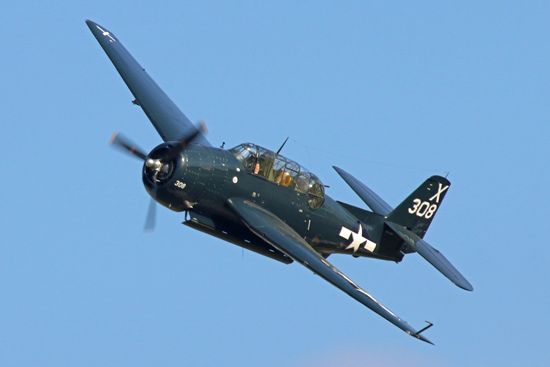Grumman TBF
Avenger
(Variants/Other Names: General Motors (Eastern
Aircraft) TBM Avenger

A Grumman TBM-3E Avenger, NL7226C.
Photo by Buck Wyndham. Copyright 2015.
History: First flown on 1
August 1941, the three-seat Grumman TBF-1 Avenger torpedo-bomber
entered US Navy service just in time to participate in the Battle of Midway in June 1942.
During its World War II lifespan, the Avenger design changed very little, and this allowed
it to be built in huge quantities. Demand for the airplane was so great that the General
Motors Company was also contracted to build it, under the designation TBM-1,
beginning in September 1942.
Over 1,000 TBF/TBMs (initially called Tarpon
Mk I, and later designated Avenger Mk I) were also
used by the Royal Navy's Fleet Air Arm in both Atlantic and Pacific theaters. The Avenger
was also used by the Royal New Zealand Air Force.
The second major variant was the TBM-3,
which featured strengthened wings to allow rockets and radar pods to be carried. A large
percentage of the TBM-3s were delivered with their large dorsal turrets removed.
The Avenger's torpedo-delivery capability had a
huge impact on the Japanese fleet during the war, and its rugged simplicity made it highly
resistant to enemy air defenses. After the war, the Avenger continued to find niches in
naval aviation. The US Navy maintained it as a search-and-rescue aircraft, an all-weather
night bomber, an electronic countermeasures platform, a Carrier On-Board Delivery (COD)
aircraft, and a target tug.
In 1953, the Royal Navy began acquiring
anti-submarine warfare versions of the Avenger under the Mutual Defense Assistance Program
(MDAP). These aircraft were designated the Avenger AS Mk IV or AS
Mk V, and were used in the ASW role until the introduction of the
Fairey Gannet in 1955. Avengers were also exported under MDAP to
France, Japan, Canada, and the Netherlands.
Unbelievably, some Avengers continued earning
their keep until more than sixty years after their debut. Until recently, at least one
aerial firefighting operation used Avengers as firebombers and/or fire spotters over the
woods of Canada. Many more have found their way into the caring hands of collectors and
warbird museums.
Nicknames: Chuff; Turkey;
Pregnant Beast; Tarpon (RAF).
Specifications (TBM-3):
Engine: 1,900hp Wright R-2600-20 radial piston engine
Weight: Empty 10,545 lbs., Maximum Takeoff 17,895
Wing Span: 54ft. 2in.
Length: 40ft 11.5in.
Height: 15ft 5in.
Performance:
Maximum Speed at 16,500ft: 276mph
Climb Rate: 2060 feet per minute
Ceiling: 30,100ft
Range: 1000 miles
Armament:
Two 12.7mm (0.5 in.) forward-firing
machine guns
One 12.7mm (0.5 in.) dorsal-mounted
machine gun
One 7.62mm (0.3 in.) ventral-mounted
machine gun
Up to 2,000lb of bombs in bomb-bay
Wing-mounted rockets / drop tanks /
radar pod
Number Built: 9,836 (7,546 by
General Motors)
Number Still Airworthy: 42
Links:
Ace Pilots: Avenger page
Explore a Grumman Avenger - Warbird Resource Group's photo tour of a
TBM.
Forest Protection Ltd., Lincoln, New
Brunswick, Canada -- The last operational fleet of TBMs in the world.
Hoof's Warbirds: Avenger (PC
simulation page, but contains interesting performance data.)
Photovault
Image Archive: Avenger Photos
Rachel Carlson Scuba Park, Near
Chicago, USA
Rocky
Mountain Wing, CAF -- Operators of a TBM-3E in Grand Junction, Colorado,
USA.
U-Boat Net: Avenger
History -- Very thorough aircraft history.

[Back to Warbird Alley's Main
Page]
All text and photos Copyright 2016 The
Doublestar Group, unless otherwise noted.
You may use this page for your own, non-commercial reference purposes only.
 |